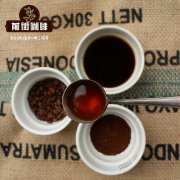How to divide Yunnan coffee grade Yunnan katim coffee information bloodline is not pure enough ah

Professional coffee knowledge exchange more coffee bean information please follow the coffee workshop (Wechat official account cafe_style)
Qianjie-introduction to Yunnan small Coffee
Although coffee has been grown in Yunnan for many years, it is still not mature enough. Its grading system is also relatively messy.
1. International commonly used grading standards:
According to the size of coffee beans, the round hole grading screen is used for classification. The international custom of small grains of coffee has a size of 10-20, and the number used represents the sieve aperture as the fraction with that number as the numerator and 64 as the denominator, in inches. For example: 14 refers to the raw coffee beans that can pass through a sieve with an aperture of more than 64 inches by 14thumb, and 19 refers to those that can be screened by a sieve with an aperture of more than 64 inches by 19thumb. (1 inch ≈ 2.54cm)
2. The common grading standards of domestic coffee:
According to the sieve hole 6.5, 6.0, 5.5, 5.0 mm is divided into five levels. First class: more than 6.5mm, full and complete particles. Second class: 6.0-6.4 mm, plump, more uniform.
Grade 3: 5.3-5.9 mm, fuller and slightly less uniform. Level 4: 5.0-5.4 mm, with incomplete rice, accounting for more than 75% of the total.
Level 5: less than 5.0mm, incomplete rice, complete accounted for more than 30%. International standard rules for inspection of defects in small grains of coffee:
It is graded according to the number of defects, and is often identified by how many defects are contained in a certain coffee bean. According to the identification method of impurities and defective beans in coffee beans stipulated by the International Standards Organization, 300 grams of coffee bean samples were taken to calculate the magazines and defective beans for classification.
Katim has always been recognized by the industry as "instant" coffee, why this is the result, there is only one reason. Katim is a large area of planting introduced by Nestl é in Yunnan, while Nestl é does instant only requires quantity rather than quality, of course, more is the ignorance of coffee farmers. Catimor, a hybrid of timor and caturra, was developed in 1959 by the Portuguese Coffee Leaf Rust Research Center (CIFC). It was popularized in Brazil in 1970s and 1980s, and coffee leaf rust crisis broke out in Central and South America from time to time also contributed to the application of catimor.
Knowledge: in 1892, French missionary Father Tian successfully planted coffee in a place called Zhukula in Yunnan, where there are still 4 coffee plants that are more than 90 years old.
In short: Qianjie is a coffee research hall, happy to share the knowledge about coffee with you, we share unreservedly just to make more friends fall in love with coffee, and there will be three low-discount coffee activities every month. The reason is that Qianjie wants to make more friends drink the best coffee at the lowest price, which has been Qianjie's tenet for 6 years!
END
Important Notice :
前街咖啡 FrontStreet Coffee has moved to new addredd:
FrontStreet Coffee Address: 315,Donghua East Road,GuangZhou
Tel:020 38364473
- Prev

Introduction to the Flavor characteristics of Alabica Coffee beans in Alpine Mountains of Yunnan Province
Professional coffee knowledge exchange more coffee bean information please follow the coffee workshop (Wechat official account cafe_style) front street-Yunnan small grain coffee introduction Yunnan Province is the main coffee producing area in China, mainly growing small seed coffee (Coffeaarabica), among which Katim series varieties are resistant.
- Next

Katim Coffee Bean shape how to distinguish the characteristics of Katim coffee defective products of Luo bean gene?
Professional coffee knowledge exchange more coffee bean information please follow the coffee workshop (Wechat official account cafe_style) front street-Yunnan small Coffee introduction Katim (catimor) is not pure Arabica blood, it is a hybrid of Timor and bourbon. Compared with the old variety, it lacks rich aroma and taste, and has a relatively shallow and fishy taste.
Related
- Beginners will see the "Coffee pull flower" guide!
- What is the difference between ice blog purified milk and ordinary milk coffee?
- Why is the Philippines the largest producer of crops in Liberia?
- For coffee extraction, should the fine powder be retained?
- How does extracted espresso fill pressed powder? How much strength does it take to press the powder?
- How to make jasmine cold extract coffee? Is the jasmine + latte good?
- Will this little toy really make the coffee taste better? How does Lily Drip affect coffee extraction?
- Will the action of slapping the filter cup also affect coffee extraction?
- What's the difference between powder-to-water ratio and powder-to-liquid ratio?
- What is the Ethiopian local species? What does it have to do with Heirloom native species?

